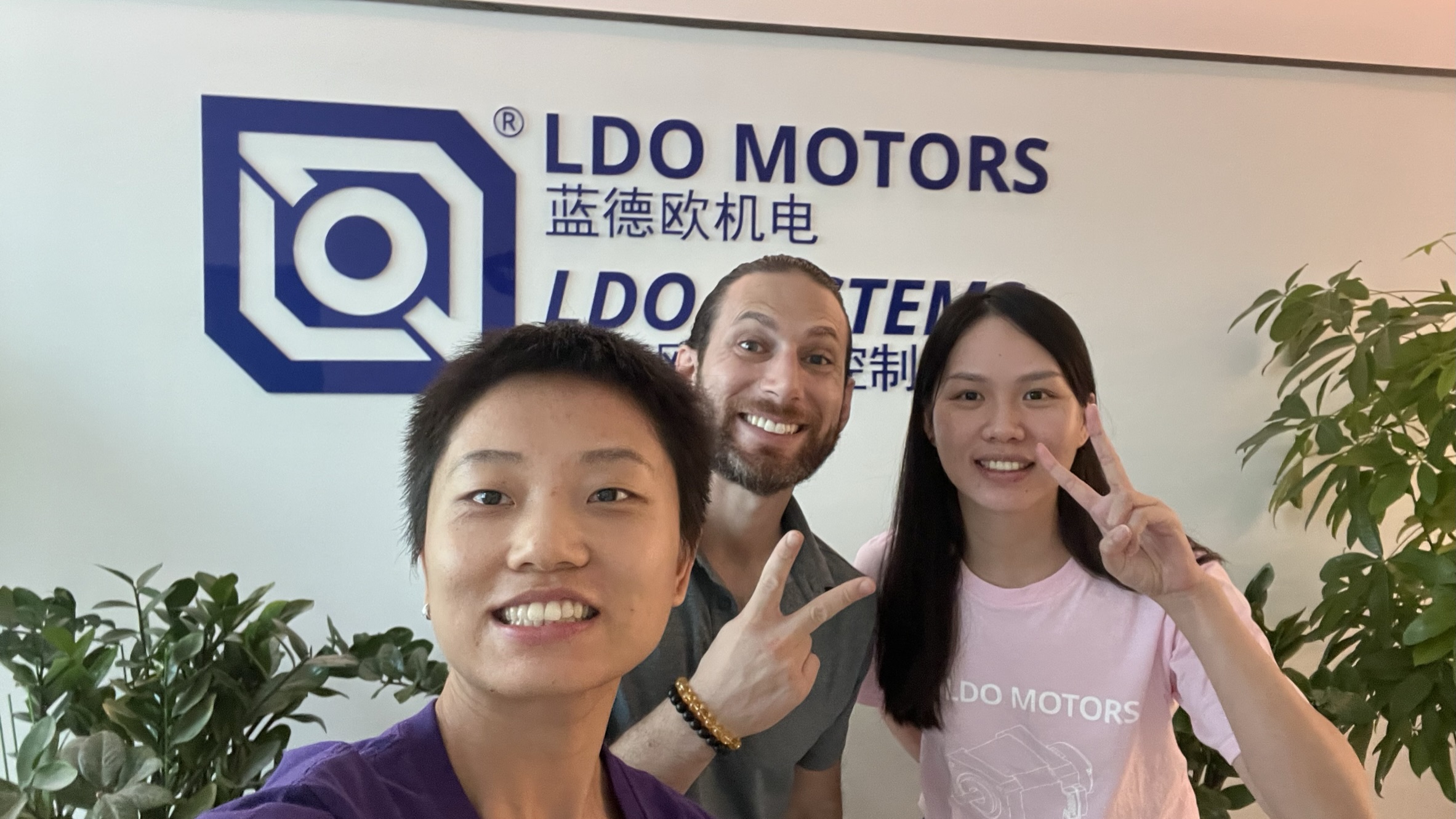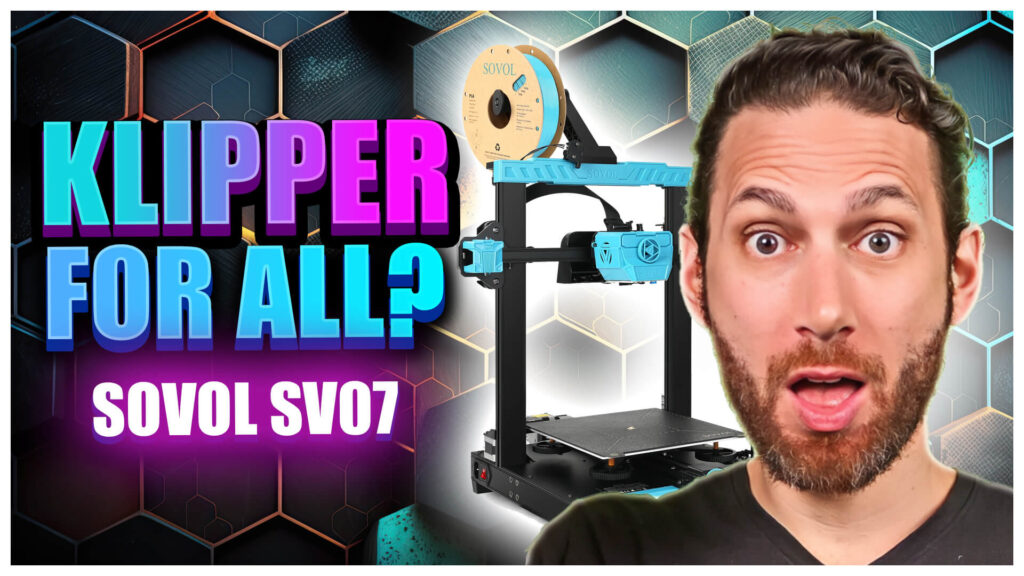Welcome to my review of the all-new Sovol SV08.
Basically, it’s a 350x350mm, professionally-manufactured remix of the popular Voron 2.4.
Except it takes less than an hour to assemble.
And it costs a fraction of the price.
And in this review, we’re going to check it out, see how it’s different, and ask the question:
Now that this thing exists, Does it still make sense to build a Voron?
Let’s get after it!
Background & Why It Exists
Now, before we get into the specs, let’s start with a little bit of background and why this printer exists, in case you’ve been living under a rock.
As we all know, a little under 2 years ago, Bambu Lab dropped an atomic bomb on the 3D printing industry with the release of their X1 Carbon. All of a sudden, an entire generation of 3D printers, namely, slow bedslingers with no cameras or connectivity, were rendered obsolete… and the industry is still reeling as a result.
Different companies have responded to this in different ways. Some have continued with business as usual, maybe tweaking a little bit here and there, but not really addressing the challenge. Some have discontinued making printers altogether, resolving that if they can’t beat them, they’ll join them, and instead creating successful accessories and upgrades for the Bambu Lab ecosystem.
Still, many companies have taken the challenge head-on, trying to create their own versions of a Bambu Lab-like printer, at an equal or even lower price, with what I would summarize as “very low, low, or moderate” levels of success.
All the while, Bambu Lab hasn’t held still, moving the mark and releasing new and more affordable printers faster than even their most well-funded competitors can replicate them.
And yet, there is a third category of company – a category that has taken a completely different track. Instead of joining the race to the bottom and trying to out-bambu bambu. This category of company has gone after a totally different market segment: the Voron segment.
You see, just a few short years ago, owning a Voron meant spending weeks self-sourcing the parts, not to mention printing and assembling everything. Then, with the arrival of ready-made kits from companies like LDO, sourcing became easy; you just had to print all the parts and spend 40+ hours building the printer itself. And that was successful; LDO alone has sold something like 10,000 voron kits in the last few years, and companies like FYSETC, FormBot, Siboor, and more probably aren’t far behind.
But now, Sovol has dropped an atomic bomb of their own on 3D printing industry. The SV08.
What Is The Sovol SV08?
So, what IS the SV08?
Well, at first glance, it’s a Voron 2.4, if instead of off-the-shelf-parts, you used the same types of industrial, large-scale manufacturing techniques that make Bambu Lab printers possible and affordable. Custom-machined aluminum frame. High-quality, injection-molded parts. Purpose-built electronics. And, of course, a combination of 90% pre-assembly in China, mixed with an ingenious design that allows this massive, 350x350mm build volume printer… to be flat-packed and shipped around the world.
But that’s just the surface level, and we’re going to get into some of the more nuanced – and surprising – features in a second, when we compare the final product to a Voron 2.4… but first, I want to ask…
Is This Ethical?
Is this ethical? I mean, one of the biggest criticisms levied at Bambu Lab is that they admittedly learned a lot from the open source community, particularly the Voron team, and then put it into their own, proprietary, closed-source printer, without giving much of anything back to the community.
Now, I don’t want to get into that whole debate in this review, and I’m not going to take a stance in that fight, but I will say that when I had the express privilege of previewing the early prototypes of the SV08 during my trip to China in September, this is one of the primary concerns I raised with Sovol.
To my relief, they were already well aware of the implications of building upon an open-source design like the Voron 2.4 and even at that early stage of the product development, they already assured me that EVERYTHING about the SV08 – the hardware, the software, the changes they’ve made to the firmware – it’s all going to be 100% open source
But since then, they’ve actually gone a step further. Sovol has actually pledged to donate $2 back to the Voron Project for each and every SV08 they sell, to support further development of future Voron machines. That might not seem like a lot, but first, wait till you hear the price of this printer… and second, keep in mind that the Voron 2.4 is, itself, completely open source. As long as they publish their design as open source and refrain from using the trademark “Voron,” companies like Sovol are well within their rights to commercialize the design however they want, and they are under no obligation to support the project financially… which, I think, makes it even cooler when they do.
Specs & Performance
So, with the ethical and upgradeability concerns effectively quashed, let’s kick back and talk specs and performance. And as I go along, I think it might be very interesting to compare the SV08 to my top-of-the-line, custom-built Voron 2.4 by LDO Motors.
For build volume, the SV08 delivers 350x350x*340, which is about 10-25mm more on Z than the Voron 2.4.
Like the Voron 2.4, it office a full AC powered heat bed, linear rails, wifi connectivity, Klipper, Quad gantry leveling… you know the deal.
As for flow rate, temperatures, and all hot-end related stuff, that’s going to depend on what kind of hot-end you have on your Voron 2.4 you’re comparing it to. The SV08, though, ships with a 0.4mm, nickel-plated, proprietary, bambu-style hot-end, capable of delivering about 25 cubic mm/s using standard, PolyMaker PolyLite PLA @ 220°C, or about 27 cubic mm/s before defects became really noticable using Creality Hyper PLA @ 220°C, which puts it behind the results I’ve achieved with the Phaetus Rapido, E3D Revo High Flow, and the Bambu Lab clone hot-end with CHT nozzle. It is, however, comparable to a stock Bambu Lab 0.4mm hot end.
The top temperatures are 100°C for the bed, and 300°C for the hot end. This is just enough for printing pretty much any material you might want to, from ABS and ASA, all the way to Nylon and Polycarbonate. However, unlike on the Voron 2.4 kit, which ships with acrylic panels, in order to print those, you’re going to need to add on side panels, which are currently in development, and will be available for purchase in the coming months.
For cooling, the SV08 makes use of both a massive 5020 b lower inside the toolhead, plus an extra 4010 blower hanging out the back – so it should, theoretically, offer superior cooling over the Voron Stealthburner toolhead. Drop me a comment if you’d like to see me run some comparison tests in a future YouTube short.
As for the interface, it’s the same monochrome LCD and click-wheel that the Voron 2.4 ships with – except in the case of the SV08, it comes ready with an HDMI interface, so you can quickly and easily swap out the LCD for an HDMI touch-screen, which will also be available for purchase shortly.
Then, there are a few things that the Voron 2.4 doesn’t have – and things which are kind of a pain in the butt to install after the fact, and which, honestly, kind of date the design. First, there’s the camera – which is greatly appreciated, although the quality of it means it’s more appropriate for remote monitoring than for churning out beautiful timelapses. Second, there is the filament runout sensor. Yes, you heard that right. The original Voron 2.4 does not include a filament runout sensor. Adding one isn’t a big deal, but it is an added expense and time investment to wire it up and configure it.
Finally, we have little quality-of-life improvements that are missing on the 2.4. It features strong handles built directly into the base of the printer, making it much easier to move than a Voron 2.4, which you can’t grab from the bottom. The toolhead cover is magnetic, for easy access. The bed has alignment tabs in the back corners. It features an ADXL accelerometer right in the toolhead board, for resonance compensation purposes. It uses Canbus, which is more expandable and will make things a lot easier should you have wiring issues in the future. There’s even a silicone brush for cleaning the nozzle before prints. And Klipper has already been upgraded out of the box, with adaptive meshing, kiauh, timelapses, and more… making this a WHOLE lot more plug and play than any Voron build I’ve done.
Setup Process
In fact, on that note, I think it’s worth talking about the setup process, and comparing it to the Voron 2.4, because honestly, specs-wise, this thing is literally just a Voron 2.4, and you can even use the same slicing profiles on it. The big different is ultimately going to be in the build quality, which we’ve talked about, and in the build process.
To be clear, there are a lot of benefits to a completely custom build, like a Voron. First, you get the opportunity to individually choose each component to suit your needs and preferences. From the hot-end, to the type of bed probe, the size of the machine, and even the colors of the printed parts. With the SV08, while I’m sure there will be a thriving aftermarket…. at least out of the box, you’re stuck with the colors and configurations they’ve chosen for you.
Second, I think it’s important to acknowledge that anyone who chooses to build a Voron is likely not doing it to save time or money. Building a Voron is a project in itself – a labor of love that really doesn’t make sense unless you enjoy the process… and personally, I really do. Building a Voron allows you to learn the ins and outs of your 3D printer, and is an extremely rewarding experience that will give you pride every time you look at the machine.
But it also takes 40 hours of mechanical assembly – if you don’t make mistakes. Combine that with 100+ hours of printing, and a handful of hours compiling, configuring, and customizing firmware.
With the SV08, you get a printer that just works – right out of the box. Setting it up took me less than an hour… and that including taking apart and re-assembling one of the Z axes because I’d pinched a wire. Each of the Z-axis assemblies is already built, with the steppers and belts pre-assembled and tensioned. All you need to do is bolt them on with 5 or 6 screws of various sizes. Then, you simply rest the flying gantry on top, bolt that down, and connect each of the connectors for all of the electronics.
To be completely honest, before the SV08, I was considering building another Voron… perhaps a Trident… since I’ve gotten rid of a few of my larger printers, and a few companies have offered me 2.4 kits to try out for free.
But after a week of playing with the SV08… I honestly don’t think I can justify investing the time. And I suspect that for a LOT of people who have been on the fence, or have wanted to build a Voron but haven’t been able to justify the time investment… this is going to be the case. And again… just wait until you hear the price.
Print Quality
But before we get into that, let’s talk a bit about print quality.
Though I will say, because this machine runs open source klipper, gives you full control over filament and print profiles, and, unlike, say, a Bambu Lab machine, actually let’s you tweak things like resonance compensation and print macros… any discussion of print quality is kind of superfluous.
The print quality on this machine, ultimately, is going to be as good as the profiles and configuration you run on it. Because the hardware is essentially a Bambu Lab hot-end on a Voron 2.4 platform… we know it’s capable of great quality. The question is how perfect the profiles will be.
For my part, I tested the early OrcaSlicer printer profiles that were supplied to me by Sovol, and found them to be fine. I experienced a little bit of stringing, which could be a filament moisture problem, or could just mean that retraction isn’t quite dialed in on these pre-release profiles. I also had a pretty significant issue with the nozzle knocking over delicate things like supports. Funny enough, this is actually something I experienced on my Voron 2.4 early on, and I was able to resolve it by increasing the Z-hop – so I recommend that Sovol do that, and, again, have a look at retraction settings, in the profiles they ship with the final printer.
Still, as you can see, even with the pre-release profiles, this printer is more than capable of churning out beautiful, aesthetic parts. And I imagine, with more testing, it’s only going to get better.
What I DON’T Like
With that said, it’s not perfect, and there are a number of things I really don’t like about the SV08.
The first is the Nozzle. I understand that more and more companies, from Comgrow and Creality to now Sovol, are coming out with proprietary nozzle types in order to achieve superior performance… but personally, and I’ve said this before, as someone who already has a ton of nozzles, including some very expensive and high-quality diamond ones, I would have really preferred if Sovol had found a way to make V6 or V6 volcano nozzles compatible with this printer, as they did in the SV07 and SV07 Plus.
Now, if I want to switch to a 0.6mm nozzle, I’m going to have to wait for those to become available for this printer, and buy them directly from Sovol. And while I appreciate them using a nickel-plated copper nozzle – and including a spare – so that I can print carbon fiber composites, if I do want to upgrade to something like a higher-flow CHT nozzle, or a much more abrasion resistant diamond nozzle, I’m probably going to be out of luck, because I find it unlikely that BondTech or DiamondBack will invest the time and money to create nozzles for a proprietary design.
So, Sovol, if you’re listening… please consider giving us a V6 adapter for this thing! Oh, and please, please… with a printer of this size, if you’re going to include an extra nozzle, make the second one a 0.6mm! In fact, while I’m making requests… I’d rather see a 0.6mm installed from the factory, with the 0.4mm in the box.
Then, there’s the noise. This machine is LOUD. The stepper motors whine when it’s moving quickly… and that huge part cooling fan is quite loud, too…. but because you won’t hear it as much if and when you add an enclosure, that probably won’t bother you nearly as much as the control board fan, which is loud, high-pitched, and always on.
To be fair, my LDO Voron 2.4 also makes a horrible, loud whine when the control board fans run, but at least on the 2.4, the fans only run when you’re heating the bed or the hot end. I understand that the SV08 is too big to be a desktop printer, and therefore is unlikely to be sitting right next to you, but the sound of this fan is so obnoxious, I don’t even really like to be in the same room with it…. And because that’s under the printer, it’s not going to be improved by an enclosure, like motor whine or cooling fan noise would be.
Hopefully, that’s something they can fix before mass production, but in case they don’t, I’d say that the FIRST upgrade you should do on this machine should be Noctua fans for the control board.
Sovol SV08 Pricing
Now that we understand the good and the bad, let’s get to the part you’ve all been wondering – the price.
Whereas a 350mm Voron 2.4 is going to cost you anywhere from $1,100 to $1,670 with printed parts and acrylic panels.
The SV08, though, doesn’t even cost half of that.
The SV08, when it goes on sale, will have a retail price of $599.
Oh, and in case you’re wondering, the panels, which are a must if you want to print ABS, ASA, or Nylon, are going to cost between $100 and $150 including shipping. That isn’t cheap, but if it includes some kind of solution for an activated charcoal filter of some sort, I think it’s well worth it. But if you only plan to print PLA and PETG… definitely save your money.
Should You Buy It?
First, I’ll say that even at $599, this thing is a steal of a deal, considering it comes fully built, and both the size and performance of the machine. Comparable large, enclosed, CoreXY machines cost significantly more, and they generally aren’t open source or upgradeable at all. And I genuinely think that if you’re considering building a Voron 2.4, you might want to reconsider it unless you’re actually looking for the build experience, or the extreme customizability.
And historically, I’ve thought very highly of Sovol and their machines. They’ve always had fantastic quality, stay true to their open source commitment, and I’ve put a LOT of hours on my SV07 and SV07 Plus with no issues whatsoever. So, the idea of them bringing their quality, expertise, and ethos to a large-format, CoreXY printer is a pretty irresistible proposition.
But there are a few things you need to consider. At 54 by 58 by 57 centimeters not including the spool holder, this is a big machine… and not everyone is going to have the space to house it. It’s also, as I mentioned, noisy, and unless that improves with the enclosure, I don’t see you wanting this anywhere where you’re going to be spending a lot of time.
Additionally, while this machine is probably going to be very, very customizable given that it’s open source, if you’re a purist, and want a printer that is built of predominantly off-the-shelf and readily-available parts, rather than potentially having to rely on one company for replacements, then this might not be the best printer for you.
It’s also not the fastest printer out there. It’s massive size, plus the lack of an auxiliary cooling fan mean that if you’re looking to churn out 12 minute benchies, or the fastest possible prototypes, you might still want to get an X1 carbon.
Lastly, I think it’s important to acknowledge that there is an increasing trend towards multicolor printing… and while it will probably be possible to retrofit an open-source Enraged Rabbit Carrot Feeder onto this printer, if you’re interested in multicolor printing, you’d be better off picking up a setup that already has an integrated material switching solution integrated out of the box.
All in all, though, this is a great machine at a great price, and given that Sovol is playing by the rules when it comes to open source and contributing back to the Voron project, I personally think it’s really cool that people can now enjoy voron-level performance without having to spend voron-level time and money.
And more than anything, I think it’s really refreshing to see a company that isn’t trying to churn out yet another 250×250 Bambu Lab clone, and has actually forged a new path, strategically, to serve an under-served segment of the market.
So if you’re in the market for a large format, open-source printer that “just works” out of the box, with an hour or less of setup, I can say that so far, I am really loving the SV08, and I can easily give it my recommendation.
Conclusion
So, there you have it, my review of one of the MOST exciting printers I’ve been keeping secret since my trip to China last year. I want to give a HUGE thank you to Sovol, for allowing me to be one of the first to release my review, and their continued support of and collaboration with the community.
Let me also take a moment to thank our YouTube Members and Patreon supporters, particularly our Nylon and PEEK Members: Chip Cox, 2 Krazy Ketos, Amir Chen, and Kris Miller. You guys rock.







